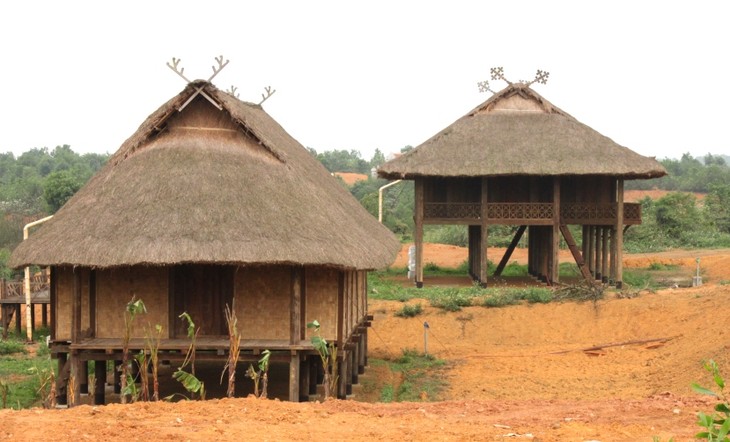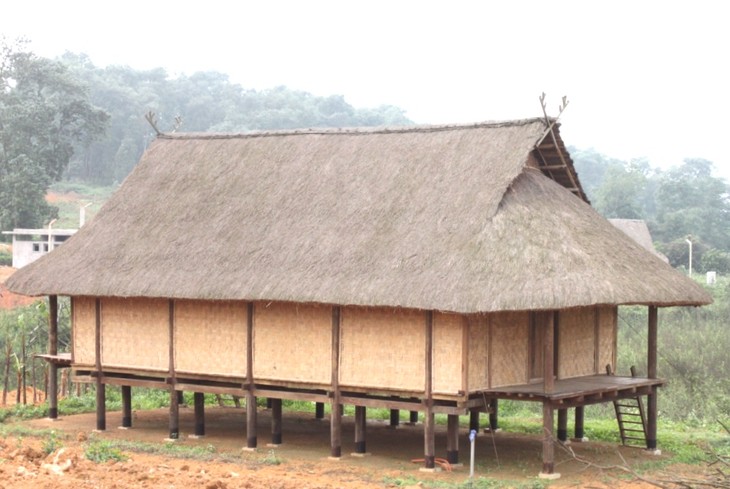(VOVworld) – Traditionally, the houses on stilts of the Thai ethnic group are located at the foot of a mountain. Each house from exterior architecture to interior furnishings reflects the Thai philosophy of human life.
 |
A Thai house has a tortoise-shaped roof (Photo: vinaculto.vn)
|
A Thai house on stilts is simple but solid. It is made of bamboo and strong reeds with a thatched roof. Instead of being nailed, the separate parts are joined by tightly knotted bamboo strings. To link pillars, the majority Kinh people use a mortise, but the Thai use ridge beams which go through the pillars. Luong Van Thiet, a researcher with the Vietnam Museum of Ethnology, told VOV: “The black Thai house has a tortoise-shaped roof because people believe a tortoise taught them o build houses. On top of the roof are two crossed bamboo poles, which are called Khau Cut. Khau Cut illustrates the house owner’s social status. A rich owner has lotus-carved poles, while a poor owner has plain pole. The newly-weds have a carved image of an expectant mother to pray for reproduction”.
 |
| A black Thai house (Photo: vinaculto.vn) |
For the black Thai, a house harmonizes earth, sky and nature. The number of house compartments and stair-steps is always odd: 3,5,7 or 9. Each house normally has two staircases. The back stairway, which has 9 steps, is for women, and the 7-step front stairway is for men. Hoang Minh Nguyet, who works at the Vietnam Museum of Ethnology, says of a black Thai house has details that symbolize yin and yang – on the handrail pillars for example: “A single woman or a married woman without babies touches the handrail pillars, hoping to get married or deliver healthy babies. The odd number of stair steps represents luck and the avoidance of evil spirits”.
House compartments are arranged according to their functions. The middle compartment, where the altar is placed, is the most important and sacred. Only men are allowed to linger there. Women, particularly daughters-in-law, must bow respectfully when passing through the compartment. Parents or sons live in the upper compartment. Daughters or daughters-in-law live in the bottom room. Researcher Luong Van Thiet says the Thai pay much attention to weaving areas: “Previously, a girl could not get married if she did not know how to weave, because her dowries consisted of items made herself like pillows, blankets and mattresses. Theses items were made in a large quantity to be given to her groom’s family members. So the weaving space is valued by the Thai. A family that has a daughter should have a loom. Otherwise, that girl will be considered lazy or useless and laughed at by society. The loom is normally placed near the window and the bed of the girl, so as to be clearly seen from outside”.
The Thai house has two cooking fires: the main one is in the middle of the house. Sitting next to the flickering flame, hosts and guests share their stories about life, bringing their relationship closer. Another fire is used for cooking daily meals. Researcher Thiet said the cooking fire reveals the culture and attitude of the owners: “Seeing the cooking fire, one can guess what that family is like. The fire is the soul of the house and the place that warms the hearts of young couple and binds family members. Bamboo baskets are put on the smoking shelf and pots and jars of fish sauce and salt are put on the ground near the fire”.
For the black Thai, a window is seen as a person’s eyes and should be wide-open. Guests are advised not to turn their back to the window.
Though lives change over time, the black Thai people in Vietnam’s northwestern region still eat sticky rice dipped in a special sauce, wear traditional costumes and live in houses on stilts, which are an enduring symbol of this ethnic group.